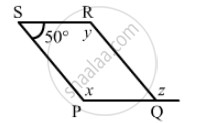Advertisements
Advertisements
Question
Two opposite angles of a parallelogram are (3x − 2)° and (50 − x)°. Find the measure of each angle of the parallelogram.
Solution
\[\text{ Oppostie angles of a parallelogram are congurent } . \]
\[ \therefore \left( 3x - 2 \right)° = \left( 50 - x \right)°\]
\[3x°- 2° = 50°- x°\]
\[3x°+ x°= 50° + 2°\]
\[4x°= 52°\]
\[x° = 13°\]
\[\text{ Putting the value of x in one angle }: \]
\[3x° - 2°= 39°- 2°\]
\[ = 37°\]
\[\text{ Opposite angles are congurent }: \]
\[ \therefore 50 - x°\]
\[ = 37°\]
\[\text{ Let the remaining two angles be y and z } . \]
\[\text{ Angles y and z are congurent because they are also opposite angles } . \]
\[ \therefore y = z\]
\[\text{ The sum of adjacent angles of a paralle\logram is equal to } 180° . \]
\[ \therefore 37°+ y = 180°\]
\[y = 180°- 37°\]
\[y = 143°\]
\[\text{ So, the anlges measure are }: \]
\[37°, 37°, 143° \text{ and } 143°\]
APPEARS IN
RELATED QUESTIONS
All rhombuses are parallelograms.
The following figure is parallelogram. Find the degree values of the unknown x, y, z.

Two adjacent angles of a parallelogram are as 1 : 2. Find the measures of all the angles of the parallelogram.
In the following Figure ABCD is a arallelogram, CE bisects ∠C and AF bisects ∠A. In each of the following, if the statement is true, give a reason for the same:

(i) ∠A = ∠C
(ii) \[\angle FAB = \frac{1}{2}\angle A\]
(iii) \[\angle DCE = \frac{1}{2}\angle C\]
(iv) \[\angle CEB = \angle FAB\]
(v) CE || AF
In a parallelogram ABCD, AB = 10 cm, AD = 6 cm. The bisector of ∠A meets DC in E, AEand BC produced meet at F. Find te length CF.
ABCD is a rhombus whose diagonals intersect at O. If AB = 10 cm, diagonal BD = 16 cm, find the length of diagonal AC.
A quadrilateral whose all sides are equal, opposite angles are equal and the diagonals bisect each other at right angles is a ______.
If all sides of a quadrilateral are equal, it is a ______.
All rhombuses are squares.
Diagonals of a quadrilateral are perpendicular to each other. Is such a quadrilateral always a rhombus? Give a figure to justify your answer.
